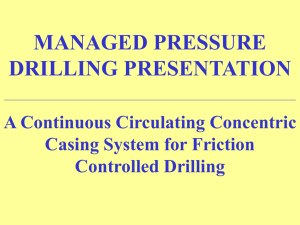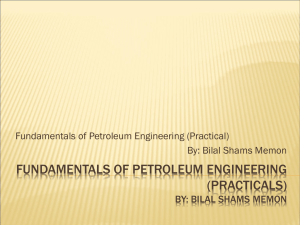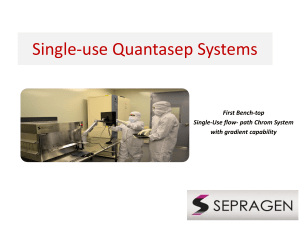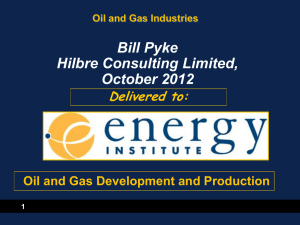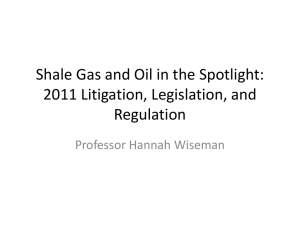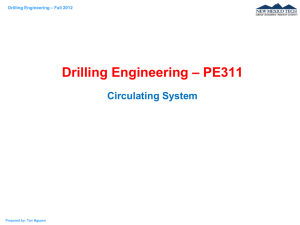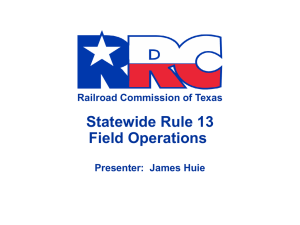Package 1 - Kankalin
advertisement
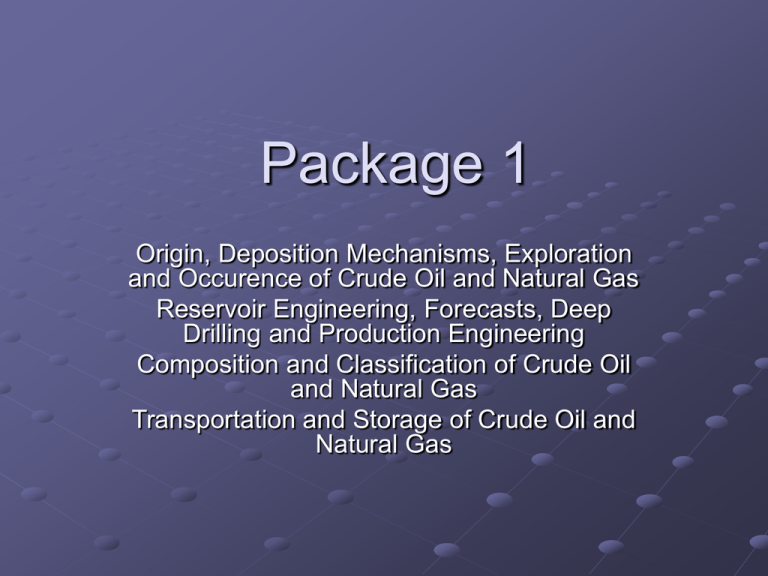
Package 1 Origin, Deposition Mechanisms, Exploration and Occurence of Crude Oil and Natural Gas Reservoir Engineering, Forecasts, Deep Drilling and Production Engineering Composition and Classification of Crude Oil and Natural Gas Transportation and Storage of Crude Oil and Natural Gas Definition Crude oil is the name given to all organic compounds which are liquid under reservoir conditions. Petroleum composition: - hydrocarbons -S, O, N, P compounds -metal compounds (V, Ni, Cu, Co, Mo, Pb, Cr, As) H2S and water Elementary composition: C 79,5-88,5%, H 10-15,5% Constituents of petroleum Alkanes Naphtenes Aromatics Classification of crude oils Paraffin based -found in deeper zones Naphtene or asphalt based –found in upper level Mixed-based –found in middle zones Composition on worldwide basis: ~30% paraffins, 40% naphtenes, 25% aromatics Natural Gas Dry and wet natural gases Components: methane, higher hydrocarbons, nitrogen, carbondioxid, hydrogen sulfide, helium Associated gas, closely connected to crude oil Natural gas---non-associated Formation of crude oil predominantly of organic origin Petroleum source rock-deposits in sedimentary basin contain organic residues of terrestrial, limnic, fluvial and marine originconversion under anaerobic conditions-resulting in bitumen or kerogen Source rock should contain 0,5% TOC Anoxic zones: nonmarine lakess (lake Tanganyika), closed inland seas with positive water balance (Black Sea deep zones), ascent of marine current from greater depths (Benguela current Africa, Humboldt current, Peru), open ocean (global climatic warming with large transgressions in Jurassic and middle Cretaceous period) Crude oil formation from phytoplankton, bacteria-in the Silurian— Devonian period Formation: organic material in sapropels is decomposed, decayed by anaerobic bacteria, organic material adsorbed onto fine clay particles, which sink to the sea floor. Sedimentation condition in Pliocene were similar to that of novadays in the offshore regions of the sea. Hydrocarbon formation Diagenesis, Catagenesis, (at depths of 1000-5000 m and 175 oC) Metagenesis Migration of oil droplets from argillaceous source rocks into porous reservoir rocks Lateral migration through capillary paths Vertical migration- fine fissures During migration occurs separation from water, gravitational separation: gas-oil-water Chemical degradation leads to smaller and more stable compounds Maturation process concludes with the conversion to methane Reservoir rocks and trap structures Fluvial sand, Beach and barrier sand, Wind-blown sand, Marine platform sand Deep water sand, Reefs, Reef limestone debris, Chalk Occurences Production and reserves Production and reserves Oil exploration preliminary exploration, exploratory wells Geological exploration Satellite images Examination of rock samples Stratigraphic investigations Geophysical investigation Magnetic measurements Gravimetric measurements Geoelectric measurements Seismic methods Refraction Reflection methods 3D method Geochemical investigation Exploratory drilling The entire exploration-to-production chain was reviewed and adapted to greater water depths: 1. The development and use of (3D) seismic was intensified. 2. Innovative drilling and production structures were designed. Because these structures could not be installed on the seabed at such great depths, FPSO (Floating Production Storage and Offloading) and TLP (Tension Leg Platform) systems were developed. 3. Efforts were made to come up with new materials for the flexibles (able to withstand high pressures at great water depths, etc.). 4. Horizontal and multibranch wells came into general use, reducing the number of wells. Estimated proved crude oil reserves in the world (A) Liquid petroleum consumed in the United States during the past 50 years came from three sources Main parameters for Conventional oil Measurement Produced-to-date Reserves Discovered-to-date Yet-to-Find Measure 873 Gb 928 1801 149 Yet-to-Produce 1077 Ultimate recovery 1950 Current consumption (2001) Current discovery rate Current depletion rate (ann. prod. as % of Yet-toProduce) 22 Gb/y 6 Gb/y 2% Peak Oil. It truly is a turning point for mankind Conventional oil - and that will be defined - provides most of the oil produced today, and is responsible for about 95% all oil that has been produced so far. It will continue to dominate supply for a long time to come. It is what matters most. Its discovery peaked in the 1960s. We now find one barrel for every four we consume. Middle East share of production is set to rise. The rest of the world peaked in 1997, and is therefore in terminal decline. Non-conventional oil delays peak only a few years, but will ameliorate the subsequent decline. Gas, which is less depleted than oil, will likely peak around 2020. Capacity limits were breached late in 2000, causing prices to soar leading to world recession. The recession may be permanent because any recovery would lead to new oil demand until the limits were again breached which would lead to new price shocks re-imposing recession in a vicious circle. World peak may prove to have been passed in 2000, if demand is curtailed by recession. Prices may remain weak in such circumstances but since demand is not infinitely elastic they must again rise from supply constraints when essential needs are affected Oil price of today: Crude Oil, Gasoline and Natural Gas Futures Prices for August 23, 2004 NYMEX Light Sweet Crude -0.67 $47.46.05 IPE Brent -0.51 $43.03 Gasoline NY Harbor -0.0098 $1.2575 Heating Oil NY Harbor -0.0149 $1.2147 -0.242 $5.310 NYMEX Natural Gas Conclusion about reserves Peak oil is a turning point for Mankind, when a hundred years of easy growth ends. The population may be about to peak too for not unrelated reasons. The transition to decline is a period of great tension when priorities shift to selfsufficiency and sustainability. It may end up a better world, freed from the widespread gross excesses of to-day. Reservoir engineering Porosity Physical properties of the pore saturating fluids: density, compressibility, viscosity Reserves = Resources x Recovery factor Multiphase flow Recovery factors: microscopic, areal, vertical The oil, gas and water distribution in a pore a) Water; b) Gas; c) Oil; d) Rock Oil recovery efficiency a./ depletion drive b./ external gas drive, small gas cap c./ external gas drive, large gas cap d./ water drive Modeling of reservoir and production performance Material balances method Reservoir simulation Steady-state flow Unsteady-state flow Decline curve methods: exponential, harmonic, hyperbolic History of drilling Deep drilling engineering a) Parked drill pipe; b) Drill hook; c) Rotary swirrel; d) Flexible hose; e) Rotary table; f) Preventer; g) Vibrating screen (shaker); h) Pit; i) Cement sheath; j) Casing; k) Hollow drill pipe; l) Circulating drilling mud; m) Drill collar as part of the drill string; n) Roller cone bit; o) Rock strata; p) Reservoir rock horizon Rotary drilling Drilling tools: roller bit Drilling mud: thixotropic liquid, contains additives, like bentonite, cellulose, emulsifiers, inhibitors, density is between 1.1 and 1.4 g/cm3 Horizontal drilling with active steering Various types of bit A) Roller bit with coarse teeth (for soft formation); B) Roller bit (for medium hard rock); C) Roller bit with fine teeth (for tough rock); D) Roller bit with hard metal inserts (for very hard formations); E) Roller cone bit; F) Jet bit; G) Diamond full-hole bit Horizontal drilling strategies A) Conventional; B) Drainhole, medium radius technology; C) Drainhole, short hole technology Mining drilling method Externally and internally smooth drill pipe Greater drilling progress Geophysical borehole measurements: electrical methods, sonic measurements, radioactivity measurements, determination of geophysical fields Productivity tests before casing, short in duration because unstable borehole Samples from the reservoir content, chemical and physical studies Schematic diagram of double core barrel a) Coupling to drill pipe; b) Overshot for pulling out with wireline; c) Outer tube, rotates core bit; d) Inner tube, nonrotating; e) Bearing; f) Mud passage; g) Ball valve; h) Core catching spring; i) Core catching cone; j) Mud channels Comparison of oil and mining core drilling A) Oil core drilling (double tube core bit); B) Mining core drilling (cable core bit) Key deep offshore technologies Deep Offshore Production Records Casing and cementation Several concentric strings of casing pipes installed according to geological and engineering requirements partly during drilling. Casing is cemented Loads on casing: Differential pressure Radial component of the formation stress Tensile strength from own weight Bending stress, especially in horizontal holes Thermal stresses Tubing string with packers transports the fluid produced to the surface Cementing 1. Massive bond of casing and formation 2. Isolation of permeable formation 3. Corrosion protection Cement + water + additives = slurry pumped through the borehole into the annulus between casing and formation, at elevated temperatures retarders and antifriction agents must be added. Production engineering The purpose of the exploitation and production planning of hydrocarbon reservoir is to produce optimum amount of sealable products at minimum cost and with close attention to all aspects of safety and ecology Problems in oil production: Time of water injection, adjust the pressure Dependence of the productivity index on viscosity of the oil and water cut Gas production and availability in the gas lift method Advantages and disadvantages of the artificial lift methods In gas production: Occurence of toxic and problematic substances Heterogeneous multilayer and selective water incursion Avoiding blowouts General production engineering Completion, Setting up production Wellhead, casing, cementing, tubing strings,bottom hole completion: „wireline equipment”. Two types: open-hole completion, casing on top of producing formation Perforation tubing-coupled perforating, it is a controlled explosion Well and reservoir treatment Well treatment Obstruction can be caused: solids from the mud, water block, swelling of the clay, chemical precipitation, emulsification. Obstructions can be removed by acid treatment (HCl or HF, surfactant) Reservoir bed treatment: pressure acidizing, hydraulic fracturing, injection of oil, water or acid together with viscosity enhancing agent, proppant (fluvial sand) Workover Workover hoist, wireline technique, coiled tubing, diameter 2,54-5,08cm, used at a depth of up to 5500m Horizontal wells: open hole, open hole with slotted or prepacked liner, slotted liner with external casing packers in the open hole, cemented and perforated liner. Bottom-hole equipment in the reservoir zone A) Main dolomite, uncased; B) Carboniferous, casing with liner; a) Tubing, 2 7/8 inch (2.22 cm); b) Cement; c) Production packer; d) Casing, 7 inch (17.8 cm); e) Liner hanger; f) Liner, 5 inch (12.7 cm) Tubing-conveyed perforation (TCP) Oil production engineering 1. Flowing production 2. Gas lift 3. Centrifugal pumps 4. Piston pumps, sucker rod or hydraulic Continuous gas-lift operation A) Schematic; a) Annulus; b) Valves closed; c) Tubing; d) Valves open; e) Production zone; B) Pressure distribution at different depths; a) Annulus pressure; b) Pressure curve in tubing for production well; c) Pressure curve in tubing for inoperative well Different types of pump A) Subsurface rod pump with walking beam drive; B) Electric submersible centrifugal pump; C) Hydraulic subsurface piston pump with pressure oil supply in the open system; a) Casing; b) Tubing string; c) Wellhead; d) Pump rod; e) Subsurface pump; f) Drive pump, g) Production pump; h) Pressure oil pump with i) Pressure raising pump on the suction side; j) Motor; k) Sealing adaptor; l) Gas separator; m) Nonreturn valve; n) Tubing drain valve; o) Three-core cable; p) Circulation piece; r) Pressure oil tank; s) High voltage transformer; t) Autotransformer; u) Switch cabinet; v) Walking beam; w) Gearing; x) Tubing anchor; y) Production packer Collection and treatment of crude oil Gas separation Dewatering and desalting Emulsion breaking: early feeding of demulsifier, moderate heating, separation in a tank Special problems in crude oil production Paraffin precipitation Chemical precipitates Sand: safe production rate, filters, consolidation by resins Corrosion Flow diagram of an oilfield a) Compressor; b) Drying; c) Line; d) Gas separator; e) Heater; f) Separator; g) Desalter; h) Tank; i) Secondary sedimentation; j) Filter Natural gas production engineering Special requirements in natural gas production High pressures and pressure differences Extreme temperature differences Aggressive gas constituents Gastight tubing, special sealing materials Controlled and monitored production Safety at the surface, underground safety valves Deep storage reservoirs Sour gas well a) Well head; b) Anchor casing; c) Cement; d) Intermediate casing; e) Injection annulus; f ) Tubing; g) Production packer; h) Liner; i) Perforations Treatment of natural gas Sulfur removal Removal of mercury Dehydration Removal of hydrocarbons Removal of carbondioxid and sulfur components Dehydration and cooling of natural gas a) High pressure separator (free water knockout); b) Heater; c) Air cooler; d) Separator; e) Joule – Thomson valve; f ) Gas – gas heat exchanger; g) External cooling system for low-pressure wells Hydrocarbon removal from natural gas a) – c) Adsorbers; d) Heater; e) Cooler; f ) Chiller; g) Separator; h) Phase separator Physical-chemical scrubbing of natural gas a) Absorber; b) Air cooler; c) Regenerator; d) Air condenser; e) Intermediate flash stage with reabsorber; f ) Reboiler; g) Phase separator; h) Expansion turbine Liqiud oxidation process Absorption of hydrogensufide Oxidation to sulfur Reoxidation of active component with air Separation of elementary sulfur a) Absorber; b) Oxidizer; c) Settling tank; d) Centrifuge; e) Recirculating pump; f ) Air blower; g) Chemical additive pump; h) Sulfur slurry pump; i) Sulfur melter Membrane separation of impurities Adsorption processes Activated charcoal, zeolites Complete natural gas treating plant a) Sour gas manifold; b) Town gas manifold; c) Disposal well – · – · – Steam; – – – – Condensate Liqiud Natural Gas Liquefied natural gas on low temperature: -160oC Pretreat the gas Refrigeration Storage Transportation: tankers Nine-stage cascade liquefaction process a) Compressor; b) Condenser; c) Accumulator; d) Phase separator; e) Heat exchanger Underground storage facility for natural gas European natural gas pipelines Trans-Alaska pipeline south of Delta Junction. The pipeline extends 800 miles from Prudhoe Bay to Valdez. Alaska Range is in the background.
